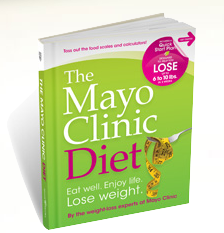If you are overweight, you have probably tried many diets and weight-loss plans: high-protein, low-carbohydrate, low fat, or other approaches. Whatever the approach, you have found there are no quick fixes and have not had much success; or, perhaps you were initially successful but quickly regained the weight as you tired of the gimmick diets. The Mayo Clinic diet (the Mayo Clinic prefers to call it a “plan”), is based on their version of the food pyramid. Its design helps you incorporate healthy behaviors into your lifestyle without reliance on fad diets. Properly followed, the Mayo Clinic diet should result in the loss of 1-2 lbs per week.
Their new diet book is available tomorrow for 42% off on Amazon.com!
Mayo Clinic Food Pyramid
The Mayo Clinic diet is symbolized by its food pyramid which is designed like the food pyramid introduced by the USDA in 1995 with the size of each level or block of the pyramid related to number of calories recommended for that level food group with size naturally decreasing as one moves up the pyramid. The major difference is replacement of the FDA’s carbohydrate base with two equally sized blocks of fruits and vegetables. The carbohydrate block is the second level. Next higher is a combined protein (fish, lean meats) and dairy products. The third level is a fats/oils block separated from sweets, which is now a small peak atop the pyramid. The sizes of these blocks reflect the number of servings of each food group allowed per day.
Portions, Servings, and Calories
An important aspect to the Mayo Clinic diet is the differentiation between food servings and portions. A serving represents a measurable amount of food such as cups, tablespoons, and ounces. These measurements and the food group define caloric content. A portion is the amount you actually put on your plate and consume. For example, a 4-inch pancake is a single serving, but a stack of three pancakes represents the portion chosen and equals three servings. Maple syrup, 1.5 tablespoons on top, would equal one serving of sweets or 75 calories, the daily limit. The Mayo Clinic diet suggests using visual cues, at least in the beginning, to gauge appropriate serving sizes.

Tennis Balls and Hockey Pucks
Common comparisons are with a tennis ball, a baseball, a hockey puck or a deck of cards. For example, a two-cup serving of spinach, about 25 calories, is roughly the equivalent of two baseballs. This equals one vegetable serving. A serving of whole-grain cooked pasta, one half-cup or 70 calories of carbohydrates, is about the same size as a hockey puck. Two-thirds of a deck of cards approximates a 2.5-ounce serving of skinless chicken or 2-ounces of lean hamburger. Each equals about 110 calories or one protein serving. Another key is to read labels that indicate number of servings per package/can as well as caloric information. Of course, you can substitute your own visual cues based on physical measurements.
The Pyramid Tool and Menus
It may take some practice judging serving sizes, but eventually you will reach a major goal of this plan. You reach that goal when proper choices become second nature and you just know what a serving of a particular food is without consciously making visual comparisons. The question then becomes the allowable portion, number of servings, of each food group that will allow you to attain a healthy weight loss.
To determine your individual diet plan the Mayo Clinic Healthy Weight Pyramid tool at their web site will assist you. Simply enter your age, height, weight, age and gender and the tool will provide you with your personal pyramid showing the number of servings allowed within each food group. For example, a 1200 calorie per day plan would allow one serving of sweets, three servings of fat (unsaturated), three protein/dairy servings, four carbohydrate servings, three or more fruit servings, and four or more vegetable servings. Making full use of diet sodas, fat free, and reduced calorie diet foods can allow some leeway in portions. For snacks, reach for more fresh fruits and vegetables. If substituting canned fruit, pour off the water or juice.
Exercise
Finally, but very importantly, within the pyramid is a circle showing walking feet and labeled “Daily Physical Activity” as a reminder that in order to lose 1-2 pounds a week, you need to utilize 500 to 1,000 calories more than you consume. This represents 30-60 minutes of daily physical activity which can include walking, running, an exercise class, or even yard work or housework if it increases heart rate.
Results
When judging your new eating and exercise plan be realistic and judge over the long term. The suggested loss of 1 to 2 pounds a week will not be dramatic. If not immediately obtained, be honest with yourself and increase your efforts to adhere to your plan particularly maintaining your exercise regimen. The Mayo Clinic diet is not a quick fix. Instead, it provides a diet plan providing a balanced, nutritious diet while achieving weight loss.



I have heard great things about this book, and I think the Mayo clinic is one of the “better” health institutions out there.
I’d take their word for anything they say, as compared to FDA, CDC, and WHO.
Also, the JHU is great too
I purchased the book, the journal and a companion cookbook at amazon.com super discounts on all and free shipping on $25 or more order!!!
Hi, I’m on my last day of the 2 week mayo clinic diet, and i have to say having really needed to kick start myself into loosing weight this diet has really helped and I have as at today’s date (07/05/10) lost 12lbs. I am going to have a break over the weekend but come Monday I am going to combine the advised meal plan with healthy eating and exercise classes to try and loose another 12-18lbs. It is well worth giving it a go.